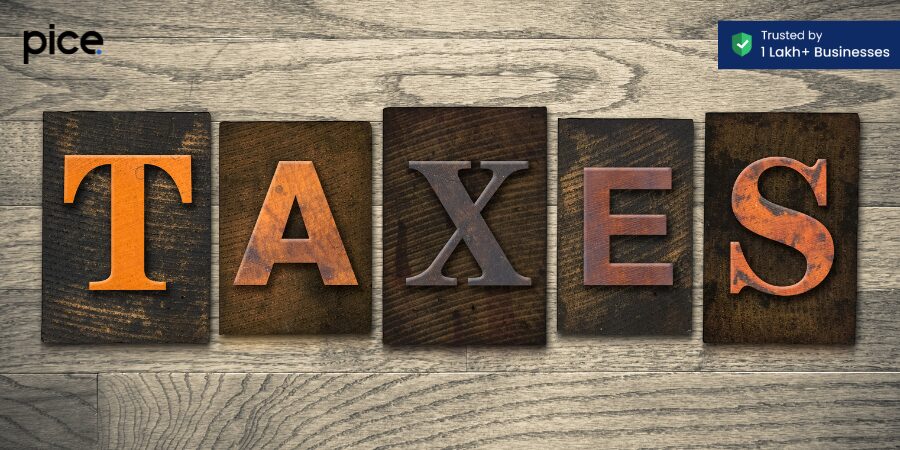Everything you need to know about types of taxes in India after GST
- 20 Sep 24
- 14 mins

Everything you need to know about types of taxes in India after GST
Key takeaways
- Public Services: Taxes fund essential services like healthcare, education, and infrastructure, improving the overall quality of life.
- Economic Growth: Tax revenue supports infrastructure development and public investments, driving economic progress and job creation.
- Social Welfare: Taxes finance social programs and benefits, reducing inequality and providing safety nets for vulnerable populations.
- Legal Compliance: Paying taxes ensures adherence to legal and regulatory frameworks, promoting transparency and fairness.
- Environmental and Health Benefits: Specific taxes, like health cess, contribute to health infrastructure and environmental protection, ensuring sustainable development.
Taxes are essential for the functioning of any government, providing the necessary funds for public services and infrastructure. In India, taxes are broadly categorized into two types: direct taxes and indirect taxes. Each category encompasses various tax acts and regulations that individuals and businesses must comply with.
What is Direct Taxes?

Direct taxes are those that the person or organization that is subject to them pays directly to the government. These taxes are levied on income, wealth, and property. Direct taxes, in contrast to indirect taxes, are the responsibility of the taxpayer who receives the income or owns the property.
Income Tax Act
The Income Tax Act of 1961 is the primary legislation governing the levy of income tax in India. It outlines the rules for calculating taxable income, tax rates, exemptions, and deductions. Under this act, individuals, Hindu Undivided Families (HUFs), firms, companies, and other entities are required to pay tax on their taxable income. The act also specifies various tax slabs and rates for different categories of taxpayers.
Wealth Tax Act
Although the Wealth Tax Act has been abolished as of 2016, it previously imposed a tax on the net wealth of individuals, HUFs, and companies. The act required taxpayers to pay tax on the value of their assets, including real estate, jewelry, and other valuables, minus any debts owed on these assets.
Gift Tax Act
The Gift Tax Act, introduced in 1958 and later abolished in 1998, was reintroduced under the Income Tax Act. Under this provision, gifts exceeding a certain value are now taxable as income. Gifts received from non-relatives are subject to tax if their aggregate value exceeds a specified limit.
Corporate Tax
Corporate tax is levied on the profits of companies. The rate varies depending on the type of company (e.g., domestic or foreign) and its annual turnover. The Income Tax Act specifies different rates for different categories of companies, including incentives and exemptions for certain types of income and investments.
Securities Transaction Tax (STT)
Securities Transaction Tax (STT) is a tax levied on transactions done on the stock exchanges. It is applicable to the purchase and sale of equity shares, derivatives, and other securities. The rate of STT varies based on the type of security and the transaction (e.g., delivery-based, intraday, futures, and options).
Capital Gains Tax (CGT)
Capital Gains Tax (CGT) is levied on the profit from the sale of capital assets. These assets include property, stocks, bonds, and other investments. CGT is classified into short-term capital gains (STCG) and long-term capital gains (LTCG), depending on the holding period of the asset. STCG applies to assets held for a short duration (e.g., less than 36 months for real estate), while LTCG applies to assets held for a longer duration. The tax rates and exemptions for CGT vary based on the type and duration of the asset held.
New Tax Slabs of Income Tax for Financial Year 2023-2024
| Annual Income (INR) | Tax Rate |
|---|---|
| 0 - 2,50,000 | Nil |
| 2,50,001 - 5,00,000 | 5% |
| 5,00,001 - 7,50,000 | 10% |
| 7,50,001 - 10,00,000 | 15% |
| 10,00,001 - 12,50,000 | 20% |
| 12,50,001 - 15,00,000 | 25% |
| Above 15,00,000 | 30% |
What is Indirect Tax?

Indirect taxes are those taxes that are not directly paid by an individual to the government but are collected by an intermediary (such as a retailer) from the person who ultimately bears the tax burden (such as the consumer). These taxes are included in the price of goods and services and are ultimately passed on to the end consumer. They are typically applied to transactions involving goods and services.
Sales tax
- A sales tax is a fee that the government imposes on the purchase of goods and services. At the point of sale, the seller collects it from the buyer and then pays the government. The tax rate may vary based on the type of goods or services and the jurisdiction.
Service Tax
- Service tax was a tax levied on services provided in India, which has now been subsumed into the Goods and Services Tax (GST). Service providers tacked on a fee and gave it to the government.
Goods and Service Tax (GST)
Goods and Service Tax (GST) is a comprehensive indirect tax levied on the supply of goods and services in India. It has subsumed various other indirect taxes like VAT, service tax, excise duty, and more. GST is divided into:
- Central GST (CGST)
- State GST (SGST)
- Integrated GST (IGST)
Value Added Tax (VAT):
- Value Added Tax (VAT) is a multi-stage tax levied on the value added at each stage of production and distribution of goods and services. The end user is ultimately responsible for collecting it at each stage of the supply chain. In India, GST has now taken the place of VAT.
Customs Duty and Octroi
- Customs duty is a tax imposed on imports and exports of goods. It includes various types, like essential customs duty, anti-dumping duty, and export duty. Octroi was a local tax collected on goods brought into a town or city, which has now been largely abolished or integrated into GST.
Excise Duty
- Excise duty, also known as the Central Value Added Tax, is a tax levied on the manufacture of goods within the country. It is imposed at the time of manufacture and is typically included in the price of the product. This duty has also been subsumed into GST.
Advantages of Direct Tax
- Equity: Direct taxes are levied based on the taxpayer’s ability to pay. Individuals and entities with higher incomes or wealth pay more taxes, ensuring a fair distribution of the tax burden.
- Certainty: Direct taxes provide certainty to taxpayers as the tax rates and the amount to be paid are usually fixed and clear, allowing better financial planning.
- Elasticity: Direct taxes are flexible and can be adjusted based on the economic needs of the country. For instance, tax rates can be increased during times of national need to generate additional government revenue.
- Reduction of Inequalities: Progressive direct taxes help reduce income inequalities by imposing higher taxes on the rich and providing benefits and exemptions to lower-income groups.
- Government Revenue: Direct taxes are a significant source of government revenue, which is essential for funding public services, infrastructure, and development projects.
- Tax Benefits: Taxpayers can avail of various deductions and exemptions under direct tax laws, such as those on investments in mutual funds, property ownership, and agricultural land.
- Central Governments: Direct taxes are an essential tool for central governments to regulate and control the economy, influencing economic behavior and ensuring compliance with fiscal policies.
- Tax Deducted at Source (TDS): Ensures regular and timely collection of taxes from various sources, providing a steady flow of revenue to the government.
- Tax Compliance: Direct taxes, such as corporation tax and import tax, require detailed documentation and compliance, which helps in maintaining transparency and accountability.
Disadvantages of Direct Tax
- Tax Burden: Direct taxes can place a significant financial burden on taxpayers, particularly in higher income brackets, leading to a reduction in disposable income and potential discouragement of investment and savings.
- Evasion and Avoidance: High rates of direct taxes may encourage tax evasion and avoidance, reducing the overall efficiency and effectiveness of the tax system.
- Administrative Costs: The collection and administration of direct taxes involve significant costs, including the maintenance of tax records, audits, and enforcement measures.
- Complexity: Direct tax laws, such as those related to income tax, corporation tax, and customs duties, can be complex and difficult for taxpayers to understand, requiring professional assistance and increasing compliance costs.
- Economic Impact: High direct taxes can negatively impact economic growth by reducing the incentive for individuals and businesses to earn more, invest, and expand.
- Inflationary Pressure: In some cases, direct taxes can lead to inflationary pressure, as businesses may pass on the tax burden to consumers in the form of higher prices.
- Essential Custom Duty: While necessary for protecting domestic industries, essential custom duties can increase the cost of imported goods, affecting consumers and businesses reliant on foreign products.
- Foreign Company: Direct taxes on foreign companies can deter foreign investment and trade, impacting the country’s global economic relations.
- Municipal Corporation: The distribution of property taxes by municipal corporations may be inequitable, which can result in inequalities in local government infrastructure and services.
- Provision of Services: The burden of direct taxes can affect the provision of services by both the public and private sectors, potentially reducing the quality and accessibility of essential services.
Advantages of Indirect Tax

- Ease of Collection: Indirect taxes are generally easier to collect as they are included in the price of goods and services and collected by intermediaries (retailers or service providers) on behalf of the government.
- Broad-Based Taxation: Indirect taxes reach a larger section of the population, including those who might not fall under the direct tax bracket. This ensures a broader tax base.
- Non-Evasion: Since indirect taxes are collected at the point of sale or service, it is difficult for consumers to evade these taxes, ensuring steady revenue for the government.
- Encourages Savings and Investment: By taxing consumption rather than income, indirect taxes encourage people to save and invest more, which can promote economic growth.
- Flexibility: Indirect taxes like customs duty and excise duty can be adjusted to protect domestic industries and control the import and export of goods. For example, anti-dumping duty and essential custom duty are tools to regulate trade and protect local businesses.
- Revenue Generation: Indirect taxes contribute significantly to government revenue, which is crucial for public spending and infrastructure development.
- Consumption Control: Taxes on specific goods and services (like sin taxes on tobacco and alcohol) can be used to discourage the consumption of harmful products.
- E-Way Bills and E-Invoicing System: The use of electronic waybills and e-invoicing systems has streamlined the process of collecting indirect taxes, reducing paperwork and improving compliance.
Disadvantages of Indirect Tax
- Regressive Nature: Indirect taxes can be regressive as they take a larger percentage of income from low-income individuals than from high-income individuals, leading to inequity.
- Inflationary Impact: Indirect taxes can increase the cost of goods and services, leading to inflation. This can affect consumer spending and overall economic stability.
- Administrative Costs: Implementing and maintaining systems for collecting indirect taxes (such as GST returns, E-Way Bill System) can be costly for both the government and businesses.
- Tax Burden on Consumers: The burden of indirect taxes ultimately falls on consumers, which can reduce their purchasing power and affect their standard of living.
- Complexity: The tax structure can be complex, with various rates and exemptions for different goods and services. This complexity can lead to confusion and increased compliance costs for businesses.
- Impact on Business Compliances: Businesses need to comply with various indirect tax laws, such as filing monthly returns and maintaining detailed records. This can be time-consuming and requires significant resources.
- Distortion of Market Prices: Indirect taxes can distort market prices, leading to inefficiencies in the allocation of resources. For example, high customs duty on imports can make foreign goods more expensive, affecting consumer choice.
- Economic Disparities: While indirect taxes provide significant revenue to the government, they can also exacerbate economic disparities if not carefully structured to protect lower-income groups.
Difference Between Direct And Indirect Tax
| Feature/Aspect | Direct Tax | Indirect Tax |
| Definition | Tax paid directly to the government by the individual or organization on whom it is imposed. | Tax collected by an intermediary (like a retailer) from the person who ultimately bears the tax burden (like the consumer). |
| Common Type | Income Tax, Corporate Tax, Property Tax | GST, VAT, Sales Tax, Excise Duty, Customs Duty |
| Type of Tax | Progressive | Regressive |
| Who Pays | Property Owner, Person Resident, Body Corporate | Consumer, Person Resident, Property Owner |
| Legislation | Income Tax Act, Corporate Tax Rate, Annual Return | Central Goods and Service Tax Act (CGST), Customs Duty Applicable, ERP E-TDS Return Filing Solution |
| Rate Determination | Based on Annual Income, Corporate Tax Rate | Based on transaction value, consideration for sale |
| Evasion | Higher potential for evasion | Lower potential for evasion |
| Impact on Prices | Does not affect prices of goods and services | Increases the prices of goods and services |
| Revenue Stability | More stable and predictable | Can be less stable and unpredictable |
| Administrative Ease | More complex and costly to administer | Easier and less costly to administer |
| Inflationary Effect | No direct impact on inflation | Can contribute to inflation |
| Equity | More equitable as it is based on the ability to pay | Less equitable as it is the same for everyone |
| Compliance | Higher compliance costs | Lower compliance costs |
| Tax Burden | On individuals and corporations | Ultimately on consumers |
| Exemptions and Deductions | Exemption from Income Tax, Basic Exemption Limit | Exemption for Import |
| E-Way Bills | Not applicable | Applicable for the movement of goods |
| Electronic Systems | E-Invoicing System, E-Invoicing Threshold | E-Way Bill System, Facility for Online Payment of C |
| Customs Duty | Import Tax, Decrease in Customs Duties | Customs Duty Applicable, Component of Customs Duty |
| Stamp Duty Rates | Burden of Stamp Duty, Duty for Property Exchange | Level Stamp Duties |
| Returns and Compliance | Annual Return, Filing of Returns, Income Tax Returns | GST Returns, Monthly Returns, Form GSTR-1, Form GSTR-2B, Form GSTR-3B, Form GSTR-8 |
What are the benefits of paying taxes?
Paying taxes supports essential services and societal development:
- Public Services: Funding for education, healthcare, and infrastructure.
- Social Safety Nets: Financial aid for the elderly, disabled, and low-income families.
- Public Safety: Supporting police, fire departments, and national defense.
- Economic Development: Investments in technology, research, and infrastructure.
- Environmental Protection: Funding conservation and renewable energy initiatives.
- Community Development: Supporting libraries, museums, and cultural programs.
Are There Any Penalties for Not Paying Taxes?
Yes, there are penalties for not paying taxes. Here are some key points:
- Penalties and Fines: Individuals and Indian companies can face significant penalties and fines for failing to pay taxes on time. These can include interest charges on the amount owed and fixed penalty fees.
- Legal Consequences: Non-payment of taxes can result in legal action, including prosecution. Indian Tax authorities can take action against individuals and companies, including the seizure of assets and property.
- Loss of Benefits: Non-payment can lead to the loss of certain benefits and privileges, such as the benefit of amnesty schemes and export benefits.
- Impact on Credit: Tax evasion can negatively impact an individual's or company's credit rating, making it difficult to obtain loans or other forms of credit.
- E-Commerce and Online Sales: Specific penalties apply to e-commerce services and online sales if taxes are not properly declared and paid.
Conclusion
Overall, understanding the various types of taxes in India is crucial for compliance and effective financial planning. Whether direct or indirect, taxes play a significant role in the country's economic development and governance. By paying taxes, citizens contribute to nation-building and the provision of essential services.
💡If you want to pay your GST with a credit card, then download Pice Business Payment App. Pice is the one stop app for paying all your business expenses
 By
By 


















